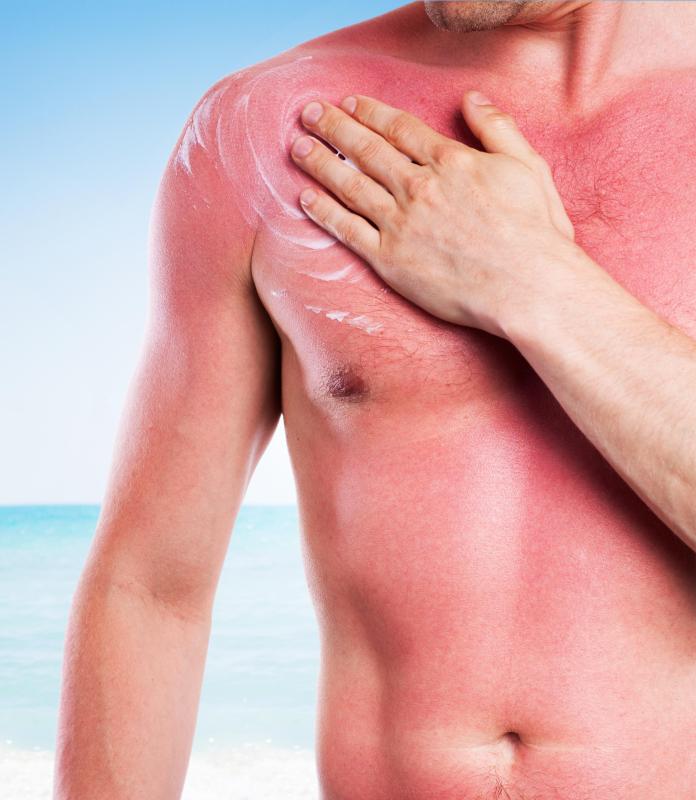At WiseGEEK, we're committed to delivering accurate, trustworthy information. Our expert-authored content is rigorously fact-checked and sourced from credible authorities. Discover how we uphold the highest standards in providing you with reliable knowledge.
What is a Bulla?
A bulla, bullae in plural, is the medical term for a large, thin-walled and fluid-filled blister. The walls of this type of blister are translucent, and the fluid inside can consist of lymph, blood, pus or serum, meaning any kind of clear bodily fluid. A bulla most commonly occurs on the skin, but can also form on the corneas and on the membranes lining the inside of the body, such as the mouth, nose, throat and lungs. Common causes include insect bites, infection, burns, the herpes simplex virus and allergic skin reactions. Recommended treatments include protecting the blister with a bandage and the application of medicated creams or lotions.
In Latin, bulla means a bubble, stud or knob, and the term is particularly used for a rounded protrusion that is hollow or filled with fluid. In medical terms, a blister has to have a diameter greater than 0.2 inches (0.5 cm) to be called a bulla. Smaller blisters are called vesicles. A blister formed on the membranes lining the inside of the lungs is called a bleb.

A bulla is often formed as the result of a skin injury such as frostbite or some kind of burn, including sunburns, chemical burns and friction burns. The herpes simplex virus commonly causes this type of blister, and it is then often called a cold sore. These kinds of blisters can also be caused by contact with certain poisonous plants and creatures, such as poison ivy and jellyfish. In some cases, more serious medical conditions such as chicken pox, thyroid disease and lupus can also lead to the formation of bullae.

A blister can be epidermal or subepidermal, depending on whether it is formed between two layers of skin or underneath the skin. An epidermal blister occurs when two layers of the outer-most layer of the skin, called the epidermis, separate and fluid is trapped between them. In the case of a subepidermal blister, there is a separation between the epidermis and the skin's underlying structure, called the subepidermis, and fluid then fills the affected area.

In order to avoid pain and possible infection, the skin covering a bulla should not be removed. Recommended treatments include applying an antibiotic or antiseptic cream and protecting the blister with a bandage or other form of skin dressing. Tincture of benzoin is also a recommended treatment for blisters. Home remedies like tea tree oil, lavender oil, aloe vera gel and petroleum jelly can also be used.
AS FEATURED ON:
AS FEATURED ON:















Discussion Comments
The blisters or cold sores that are caused by the herpes simplex virus are very annoying. They usually appear on the corner of the mouth. I used to get them, but I haven't had one in a long time. They peel and crack and it takes forever for them to heal.
Since cold sores are caused by a virus, I think the only way you can prevent them is to keep your immune system healthy and the virus suppressed.
My mom once had a large blister or bulla on her lower back. It was probably an inch wide. She called it a boil. I don't know if it is the same as a bulla.
It was very painful and was filled with blood and pus. She washed it every night and bandaged it. It took a long time for it to heal up and she never figured out what caused it.
@drtroubles - If you have a broken bulla I would suggest that you just keep it clean and make sure that remains properly cared for. Keep using the cream you have and keep it protected under a bandage. Whatever you do don't squeeze it as you may contaminate the area and raise your chance of infection.
I have had a quite a few broken blisters in the past and they can be really painful. They can also get infected easily. I would say that if your blister starts to look really red or hurts too much you should head to a doctor and get it checked. Nothing is worse than having an infection that gets out of control.
If you accidentally break a bulla what is the best way to care for it?
I had a very large blister on my foot that was caused by a pair of new ill-fitting running shoes. My blister was doing great until I snagged it on my pant leg and it started to leak. I had been applying cream to it and keeping it covered, but now I am not sure if I should keep doing the same thing or not. It already hurts quite a bit and I don't want to make things worse for myself by getting an infection.
Do you think I should go to a doctor to get it checked out or do you think it is better if I just keep taking care of it and leave it be?
Post your comments